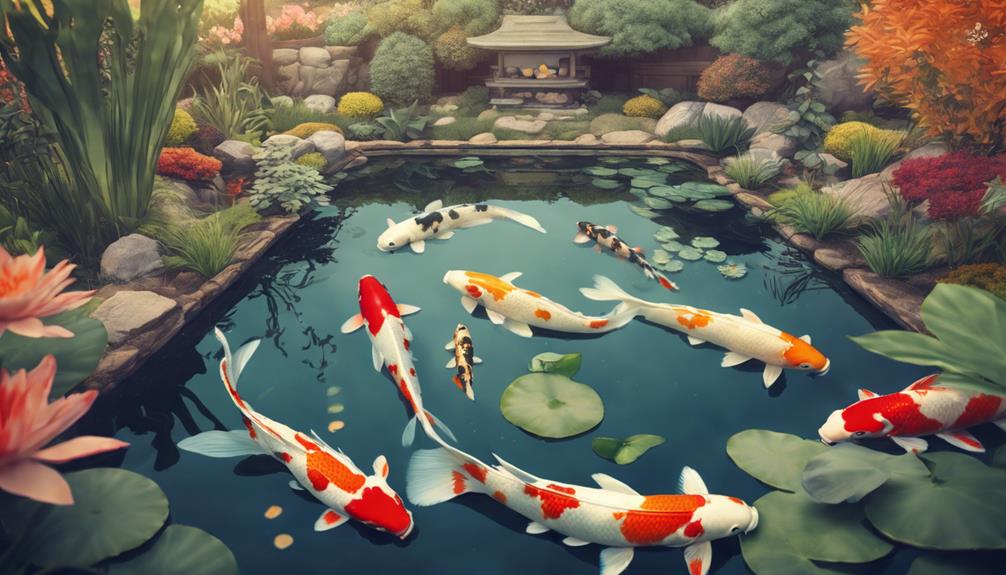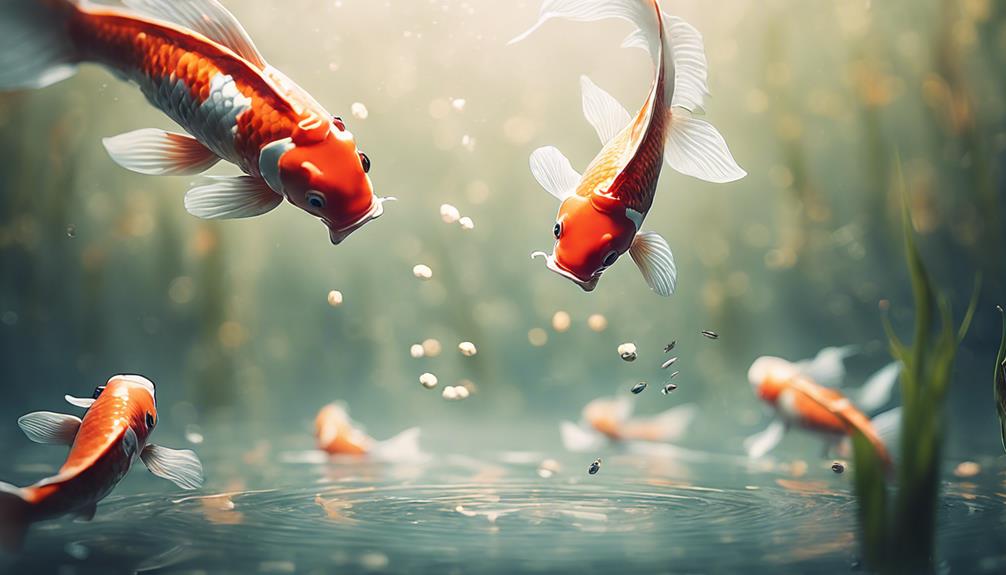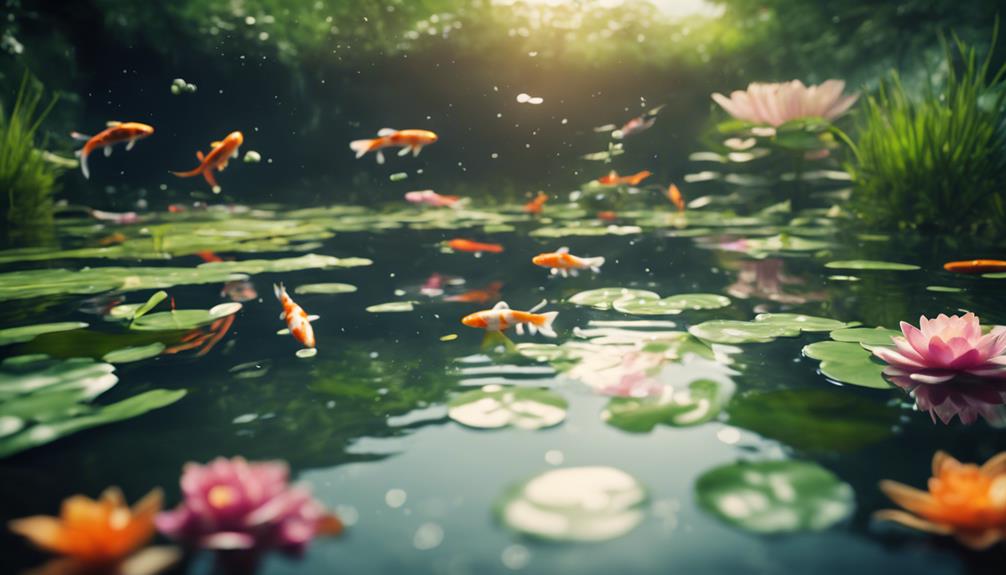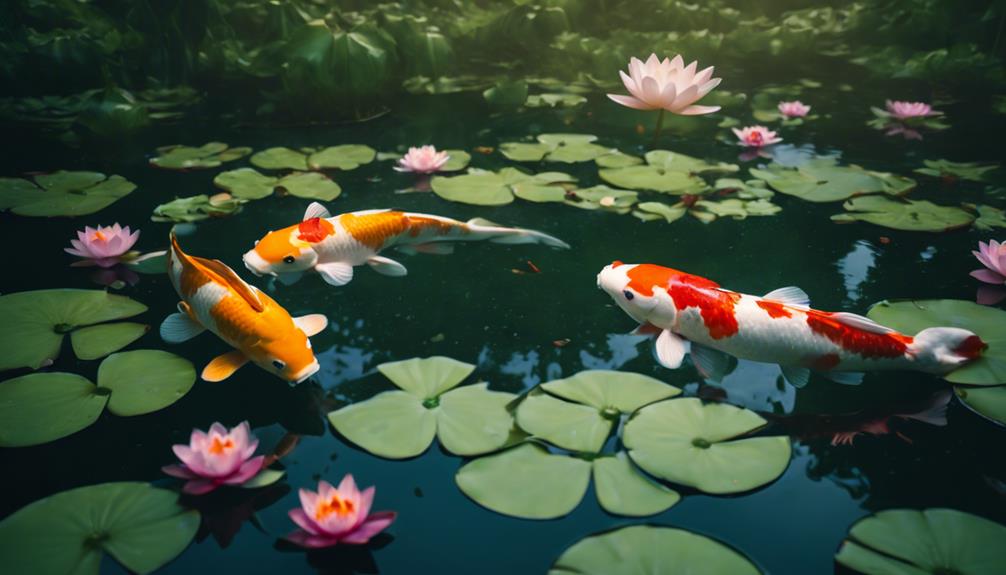You'll want to craft a feeding strategy that mimics your koi's natural eating habits and meets their nutritional needs, which vary depending on age, water temperature, and seasonal changes. Aim for a balanced diet with 25-35% protein and 5-10% fat, and feed small amounts three times a day to prevent overfeeding. Adjust your strategy seasonally, and consider factors like pond size and koi behavior to optimize health, growth, and vibrant colors. By fine-tuning your approach, you'll be well on your way to raising thriving, healthy koi – and there's more to discover to take your breeding to the next level.
Table of Contents
Key Takeaways
- Feed koi three times a day, in the early morning, early afternoon, and late afternoon, to meet their feeding needs and promote peak growth.
- Provide a varied diet that replicates their natural eating habits in the wild, including a mix of carbohydrates, proteins, and fats.
- Determine the ideal feeding schedule and food choices based on factors such as water temperature, koi age, and pond size.
- Disperse small amounts of high-quality koi food, such as Kodama Koi Food, and clean out any extra food after 20 minutes to maintain water quality.
- Adjust koi diet seasonally to accommodate changes in metabolic rates and nutritional needs, such as feeding low-protein, high-carb foods in winter.
Understanding Koi Nutrition Needs
When it comes to breeding ideal koi, understanding their nutritional needs is essential, as a well-balanced diet directly impacts their health, growth, and vibrant colors.
You want to guarantee your koi fish food provides the necessary nutrients they require. In the wild, koi eat a varied diet, which you should replicate in a controlled environment.
A well-balanced diet for koi includes a mix of carbohydrates, proteins, and fats, with a recommended protein content of 25-35% and a fat content of 5-10%.
As a breeder, you need to weigh the different nutritional requirements at different stages of their life. For instance, younger fish require more protein, while older fish need more fiber and less protein.
Look for high-quality koi food that includes a mix of ingredients like fish meal, shrimp meal, quality Spirulina, and wheat germ. These ingredients provide a broad spectrum of nutrients, including proteins, vitamins, and minerals, which are pivotal for your koi's peak health and growth.
Optimal Feeding Schedules and Tips
To guarantee peak health and growth, you should establish a feeding schedule that simulates their natural eating habits and prevents overfeeding, which can lead to water quality issues and other problems.
When you feed koi, stick to a schedule of three times a day – early morning, early afternoon, and late afternoon – to mimic their natural eating habits and promote healthy growth.
During each feeding time, feed them up to four times, dispersing small amounts of quality koi food, such as Kodama Koi Food, and only as much as they can eat in five minutes. This will prevent overfeeding and maintain water quality.
Make sure to clean out any extra food after 20 minutes to prevent decay, which can harm koi health.
Additionally, avoid feeding koi before storms, as they need more oxygen while digesting food, and low oxygen levels can stress or even kill them.
Seasonal Dietary Adjustments

As you maintain your koi's ideal feeding schedule, you'll need to adjust their diet to accommodate seasonal changes that affect their metabolic rates and nutritional needs. When water temperature drops, your koi's metabolism slows down, and they require less food. In the colder months, crucial to feed them foods that are easy to digest, such as Season-Wheat Germ or Kodama Koi FoodAll Season.
Seasonal dietary adjustments you can make:
| Season | Water Temperature | Feeding Strategy |
|---|---|---|
| Winter | < 50°F (10°C) | Feed low-protein, high-carb foods like Season-Wheat Germ |
| Spring | 50°F – 65°F (10°C – 18°C) | Gradually introduce Koi pellets to maximize koi growth |
| Summer/Fall | > 65°F (18°C) | Feed FoodAll Season to support peak growth and health |
Recommended Koi Food Products
You'll want to stock up on high-quality koi food products that cater to your fish's specific needs, ensuring peak health, growth, and coloration.
When it comes to types of koi food, there are several options available. For a high-protein treat, consider Flukers Freeze-Dried Shrimp or Tetra Pond Jumbo Krill, both available on Amazon.com.
Mr. Kodama Koi Food Color Up is a popular choice among koi breeders, as it enhances color and health with high-quality spirulina. If you're looking to improve your koi's appearance, Hi Silk 21 Koi Food is a great option, producing a silky sheen and enhancing white skin.
For a convenient and healthy treat, Manda Fu Koi Treats are suitable for training, low temperatures, and easy digestion. When feeding koi, crucially, you'll need to choose food pellets that meet their specific needs.
Koi Eating Habits and Behavior

With the right food in place, understanding your koi's eating habits and behavior becomes essential in optimizing their growth and overall well-being.
You need to recognize that koi eat in five distinct ways: surface feeding, mid-water feeding, bottom feeding, and natural foraging.
This means you should provide a varied diet that caters to these different feeding styles. For instance, you can feed your koi floating pellets for surface feeding, and sinking pellets for bottom feeding.
Live Koi Fish also have a natural instinct to forage for food, so incorporating foods that mimic their natural environment, such as algae or insect larvae, can help stimulate this behavior.
Kois diet should be tailored to their specific needs, and you should be aware of their feeding times and patterns to avoid overfeeding, which can lead to health problems.
Factors Influencing Koi Diet
Several factors, including water temperature, koi age, and pond size, substantially influence your koi's diet and nutritional requirements.
As a breeder, it's vital to weigh these variables when selecting the right koi foods for your fish. For instance, younger koi require more protein-rich foods, while older koi may benefit from lower-protein, higher-fiber diets.
Water temperature also plays a pivotal role, as koi metabolize food more efficiently in warmer temperatures. Additionally, the size of your pond affects the amount of food you should provide, as overcrowding can lead to digestive issues.
When choosing koi foods, look for high-quality options that prioritize digestibility and provide a balanced mix of vitamins and minerals.
Breeders in Japan, renowned for their expertise in koi breeding, recommend an eating regimen that includes a variety of foods to guarantee peak health and wellbeing. Remember, the type of food you provide can markedly impact your koi's health, so it's vital to select the best options for your fish.
Effective Feeding Strategies

When it comes to effective feeding strategies, you'll want to establish a routine that meets your koi's nutritional needs without compromising water quality.
To achieve this, you'll need to determine the ideal feeding schedule and food choices for your fish.
Koi Feeding Schedules
To optimize koi growth and health, establish a feeding schedule that mimics their natural eating habits and prevents overfeeding, a crucial aspect of effective koi breeding.
You should feed your koi up to three times a day, in the early morning, early afternoon, and late afternoon, to meet their feeding needs and promote peak growth.
When feeding, disperse small amounts of food at a time and watch your koi come up to eat. This guarantees they consume all the food and prevents overfeeding, which can harm their health and pollute their water.
Stick to the 5-minute feeding schedule, where you only feed them as much as they can eat in five minutes.
After 20 minutes, clean out any extra food to maintain water quality and prevent the growth of algae and bacteria.
Optimal Food Choices
You can guarantee your koi receive a balanced diet by selecting high-quality commercial pellets that provide all the necessary nutrients for peak health and growth. However, verifying it's crucial to supplement their diet with a variety of foods to prevent boredom and guarantee they receive a diverse range of nutrients.
Wheat germ pellets are an excellent choice, especially during spring and fall, as they're easily digestible and provide a boost of energy and nutrients.
High-protein foods like shrimp, krill, or brine shrimp provide essential amino acids for growth and development.
Spirulina is a nutrient-rich algae that can enhance koi color, improve their immune system, and support overall health. You can add it to their diet as a supplement or mix it with their regular food.
Additionally, consider adding foods rich in omega-3 fatty acids, such as salmon oil or flaxseed oil, to reduce inflammation and improve their overall health and well-being.
Frequently Asked Questions
What Do Koi Breeders Feed Their Koi?
You feed your koi high-quality pellets, supplemented with high-protein foods like live worms, commercial flakes, and organic supplements, including frozen brine shrimp, considering water temperature and food particle size to guarantee perfect nutrition.
How Do You Breed a Koi Successfully?
As you set out on the odyssey of koi breeding, you'll need to navigate the koi selection process, craft a pristine breeding environment, and master water quality control, ensuring genetic diversity and precise spawning triggers to successfully collect eggs and nurture fry development.
How Many Times a Day Should I Feed My Baby Koi?
You'll want to feed your baby koi 5-10 times a day, adjusting food amounts and frequencies based on schedules, water quality, and nutrient intake to support ideal growth rates and healthy fry development in your tank.
At What Temperature Should You Stop Feeding Koi?
When temperature drops to around 50°F (10°C), you should stop feeding your koi, as they enter a state of inactivity, and their metabolism slows down, making food scarce and reducing nutrient uptake, allowing them to benefit from seasonal fasting.
Conclusion
As you wrap up your koi breeding journey, remember that prime feeding strategies are the key to releasing your fish's full potential.
By understanding their nutritional needs, tailoring your feeding schedule, and making seasonal adjustments, you'll be well on your way to raising healthy, thriving koi.
So, 'gear up' your feeding game and get ready to reap the rewards of a well-fed koi community that'll be the 'catch' of the neighborhood!

